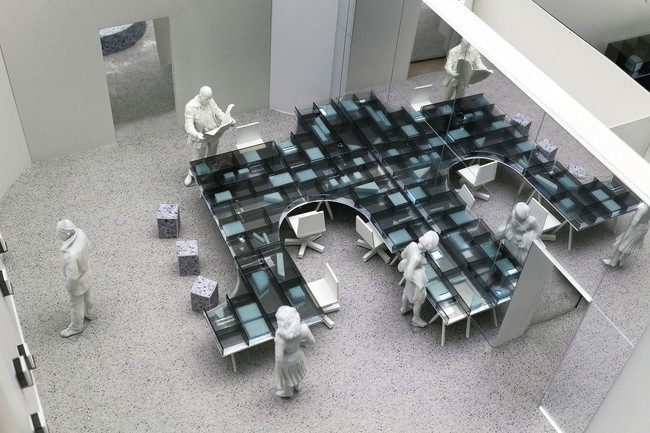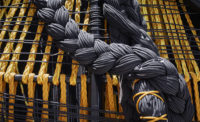
Ever the champion of far-reaching concepts, this year’s Venice Architecture Biennale director Rem Koolhaas has taken the unusual step of not only determining a theme for the main exhibitions but also asking each of the 65 independently organized national pavilions to follow his lead. Under the umbrella title Fundamentals, the architect has planned a three-part show that will include a section presenting a taxonomy of basic building components, Elements of Architecture; and Mondeitalia, a cross-disciplinary examination of the host country. For the third component, Koolhaas has decreed that the national pavilions adhere to a single theme, Absorbing Modernity: 1914–2014, asking them “to show, each in their own way, the process of erasure of national characteristics in architecture in favor of the almost universal adoption of a single modern language and a single repertoire of typologies—a more complex process than we typically recognize.”
 |
| Image © Naho Kubota / courtesy Leong Leong New York firm Leong Leong designed the pavilion’s interior to be both an exhibition space for archival material and a working office, with modular worktables that double as display cases. The firm plans to wrap the exterior of the pavilion in strips of mirrored material mimicking vertical blinds, ubiquitous features in 20th-century corporate settings. Click to enlarge. |
During the century in question, the United States has been a chief exporter of modern architecture, for better or worse. But rather than represent that history by looking at aesthetics or specific buildings, the organizers of the U.S. pavilion have decided to illuminate its influence on practice—and to do it literally, in real time.
Co-organized by New York’s Storefront for Art and Architecture, Boston-based journal Praxis, and a research team from MIT, the exhibition, titled OfficeUS, will convert the U.S. pavilion in Venice’s Giardini into a temporary architecture studio. Following an open call,
the organizers have selected eight design practitioners—an international group of four individuals and two duos—who have been working for less than 15 years, to serve as partners in an ad hoc firm. They will set up shop inside the pavilion and, with a volunteer staff, work there for the five-month duration of the show.
The plan is for the designers to produce unspecified architectural projects based on a set of 25 issues—“Best Practices,” “Trojan Horses,” “Magical States,” and “Little Americas,” among them—one for each week of the exhibition. The organizers devised the list while creating a large repository of documents, models, and material samples representing some 1,000 projects realized abroad by 200 American architecture firms over the course of the last 100 years. That archive will also serve as raw material for the designers’ work during the exhibition.
“We want to create a space for discussion and engagement with historical materials, but also for the production of design,” says Eva Franch i Gilabert, director of the Storefront, who is curating the exhibition along with Ana Miljački and Ashley Schafer. “The partners will decide over the course of each week how they want to rework that history into a contemporary object that reflects the past but also projects into the future.” The designers will collaborate with a group of 90 satellite offices around the world, connected through the OfficeUS website and with visiting experts who will stage a series of workshops related to each topic. The results will be displayed in the pavilion, on the web, and in one of four books to be published in conjunction with the exhibition. The other publications will be an overview of the exhibition, an atlas of several buildings in the archive, and a manual of office protocols drawn from actual employee handbooks, with a series of new essays.
If this sounds as if it will have the visual appeal of an all-night charette, rest assured: the organizers have enlisted New York firm Leong Leong—known for its spectacle-conjuring but intelligent work—to design the pavilion. Their plan centers on modular tables that appear to spill through the Palladian pavilion’s wings as a continuous desk, interspersed with lounging spaces for visitors. Below a surface of smoky translucent plexiglass, vitrines with mirrored bases will contain objects from the archive as well as office supplies, 3-D printers, and other ephemera typically used by a design firm. “There is this idea that cloud computing and remote technology allows us to connect and collaborate in a way that has led us to have less material stuff, but we’ve found that, in architecture offices, it’s actually the opposite—rapid prototyping and other developments have led us to accumulate more,” says Dominic Leong, a founder and director at the firm. “So the table is a hybrid, between the context of an exhibition and an office. Its shape allows for collaboration, and it also lets you see all the tools.” Documents from the archive will be displayed on small metal shelves along the perimeter walls. The organizers received $100,000 in funding from the U.S. State Department to pull off the exhibition—far less than most governments contribute to their pavilions. The organizers are still raising additional funds from private sources—they have reached nearly $700,000 to date—and are accepting donations through the project website.
What distinguishes the United States among exporters of global modernism, according to Franch, is the standardization of architecture practice that its firms fostered. “The production of protocols and office organizations is where the U.S. has contributed the most,” she says. “And we want the exhibition to produce, not necessarily a new set of practices, but a forward-looking counterpoint to those standard ways of working.”



Post a comment to this article
Report Abusive Comment